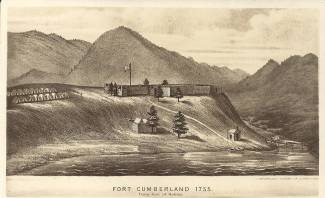Collection Name
About
Charlotte Bristowe Browne – A Nurse at Fort Cumberland
Cumberland's genesis stems from October 1749 when Christopher Gist, an agent for the Ohio Company, arrived at the junction of Wills Creek and the North Branch of the Potomac River to erect a stockade and trading post. In anticipation of the French and Indian War a fort was constructed in 1754 upon the west bank of Wills Creek and named "Fort Mount Pleasant". It was enlarged upon in 1755 and renamed Fort Cumberland by British General Edward Braddock after the Duke of Cumberland, (Prince William, younger son of King George II) commander-in-chief of the British Army. By 1829, the fort had all but disappeared. It is from this fort the city, after being known for some years prior as "Washington Town", takes its name.
The following narrative was provided by Robert Bantz, a nationally recognized historian and expert on the famed, but ill-fated march of British General Edward Braddock from Fort Cumberland to Fort Duquesne and the French and Indian War period. It is taken from the personal diary of Charlotte Bristowe Browne:
"Charlotte Bristowe Brown was the first nurse to perform her extraordinary services on a hill near Wills Creek inside a fort called Fort Cumberland, now the city of Cumberland, Maryland. Charlotte traveled with the British forces to Fort Cumberland in June of 1755. She provided care for the sick, wounded and dying in what was known as the Great War for Empire (1754-1763), or as others refer to it, the French and Indian War.
In November 1754 Charlotte and her brother, who was an apothecary with the expedition, had sailed on the ship “London”, part of the fleet transporting the 44th and 48th British regiments from England to Virginia as part of British General Edward Braddock’s army. They would follow Braddock’s army from Alexandria, Virginia, to Fort Cumberland. Braddock was to arrive earlier at Fort Cumberland on May 10th. Braddock’s mission was to march to and dislodge the French forces at Fort Duquesne in Pennsylvania, a site now known as Pittsburgh. Braddock departed on his march to Fort Duquesne from Fort Cumberland on June 9th, 1755.
On the 1st of June 1755, Nurse Browne, her brother, two nurses, a servant, two cooks and fifty sick soldiers in wagons headed for Fort Cumberland. As the group approached Cresap’s Fort in Oldtown, Maryland. she wrote in her journal: “the road was so rough that it nearly disjoined me. I walked till my feet were blister’d.” Upon arriving at Fort Cumberland, just a few days after Braddock had already departed on his march to Fort Duquesne, she wrote: “the most desolate place I ever saw - the fort has no internal water supply and is crowded with wives of the enlisted men and local families who sought protection from the local Indian attack.”
Nurse Browne worked tirelessly caring for the sick that remained at the fort during the campaign and nursed the sick, wounded and dying who arrived back at the fort on July 15 after Braddock’s defeat on July 9th at the Battle of the Monongahela six miles south of present day Pittsburgh. A few days later her brother died with a fever. She nursed the sick at the fort until following the retreating soldiers to Frederick, Maryland then on to Philadelphia, Pennsylvania and finally to a hospital in Albany, New York. She ended her journal in August of 1757, too overwhelmed with work to write any further. What happened to Charlotte Browne is unknown, but her diary has survived to provide glimpses of the life of a woman traveling with an eighteenth-century army in America and how she spent long days laboring in a fort in present day Cumberland, Maryland.
Charlotte had been widowed by the time she was appointed Matron of the General Hospital for the Braddock expedition. As she had left her children in England, she would later learn of her daughter’s death in England while serving at Fort Cumberland..."
In addition to the above, here are two excerpts taken directly from Charlotte’s journal:
Maryland - Toward Fort Cumberland - June 12 (1755) - At 2 in the morning the drum beat, but I could have wish’d it to have stay’d a few hours longer, being very sleepy. We marched but there is no describing the badness of the roads. I walked as far as I was able. The poor horses no longer regard the smack of the whip or beat of the drum, and as to Black (Charlotte’s horse) she could go on no further. 2 of the waggons broke down. At 10 we came to the river (Potomac) and waited 6 hours before we could ferry over. At 8 at night we halted at a Rattlesnake Colonels nam’d Crisop. Had for supper some lamb, to drink some bad wine, which was but 5s. a quart! I could get no bed so went to my waggon.
Maryland-Toward Fort Cumberland - June 13 (1755) - At 3 few march’d but I was so ill I could not hold up my head. 3 of the waggons broke down at 4 in the afternoon. Mr. Bass came to meet us and gave me some letters from England. At 6 we came to Fort Cumberland the most desolate place I ever saw. Went to Mr. Cherrington who receive’d me kindly, drank tea and then went to the Governor to apply for quarters. I was put into a Hole that I could see daylight through every Log, and a port hole for a window; which was as good a room as any in the fort.”
Information provided by Robert Bantz and Nina Higgins and from the diary/journal of Charlotte Bristowe Brown
Nina Higgins, an historian with the Cresap Society, further noted that many horses were lost on Charlotte’s journey, that they were driven until broken or dead.
Postcard from the collection of Angela and Albert Feldstein
